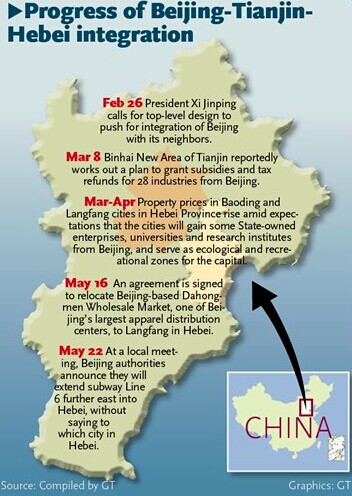

Progress of Beijing-Tianjin-Hebei integration
China's top economic planner said Wednesday that it is now drafting a plan for the coordinated development of Beijing and Tianjin municipalities and Hebei Province, and it has finished a research report on the plan.
The Beijing-Tianjin-Hebei Coordinated Development Program is of vital importance, Fan Hengshan, deputy secretary-general of the National Development and Reform Commission (NDRC), said at a press conference on Wednesday.
The commission is now "actively facilitating the drafting of the plan," Fan said.
Recent media reports said that the development plan is expected to be released in June, but financial news portal yicai.com said Wednesday that the plan may be delayed, citing a source close to the matter.
Fan said that optimizing the functions of the capital is the focus of the plan and the positioning of the three places should be made clear.
Beijing's Vice Mayor Yang Xiaochao said in April that the city will develop into a center of politics, culture, international communication and technological innovation, and experts said these will be Beijing's main functions in the future.
President Xi Jinping called for integrated and coordinated development of Beijing, Tianjin and Hebei at a seminar on regional development held in Beijing on February 26.
Some progress has already been made in seeking integrated development in the area.
On April 3, an agreement was signed with the city government of Langfang, North China's Hebei Province for the clothing wholesale market near the Beijing Zoo, known for its affordable clothing, to move to the city, which is 40 kilometers away from Beijing.
The move will redirect around 100,000 people to Hebei, media reports said.
Last month, eight clothing wholesale markets in south Beijing's Dahongmen area also signed agreements to move to Langfang.
More companies are also expected to move out of Beijing. State-owned Xinxing Cathay International Group Co confirmed earlier this month that it will move a pharmaceutical division to the city of Handan in Hebei, about 450 kilometers away from Beijing.
Companies that are about to move to Hebei are mostly those in the chemical, building material and industrial sectors, which generally require high energy consumption and generate high pollution, and media reports said that local governments in Hebei have been reluctant to accept these companies.
"Hebei itself is also facing great environmental pressure and urgently needs to upgrade its economic structure. Beijing should also consider moving some companies with more added-value to Hebei," said Zhang Gui, deputy director of the Center for Beijing-Tianjin-Hebei Development Research at Hebei University of Technology.
Zhang told the Global Times on Wednesday that a top-down blueprint from the NDRC could to some extent help to resolve the arguments between local governments, who have been fighting for quality projects that are being moved out of Beijing.
Fan said at the press conference that there is no clear-cut positioning of roles, and the division of functions in the area is currently not balanced.
"Local governments should have clear positioning and accept Beijing's projects that could benefit their own industrial advantages," Zhu Erjuan, director of the Capital Research Institute of Economics at the Capital University of Economics and Business, told the Global Times on Wednesday.
Zhu noted that Beijing is overburdened by its large population.
"Hebei should take the opportunity to develop itself, which will also ease the burden for Beijing," she said, noting that the Beijing-Tianjin-Hebei Coordinated Development Program will bring great vitality to the economic growth of the area.
The Beijing-Tianjin-Hebei area had a combined GDP of over 6 trillion yuan ($980 billion) in 2013 and a total population of more than 100 million.
Recent media reports said that the cities of Baoding, Shijiazhuang and Tangshan in Hebei Province could serve as sub-centers for Beijing.
Zhu said some healthcare and education facilities, as well as some administrative functions, could be moved to Hebei, which will help to relieve the pressure on Beijing and also boost the development of Hebei.
Blueprint coming for coordinated infrastructure of Beijing, Tianjin, Hebei
2014-05-29Financial experiment zone mulled in Beijing-Tianjin-Hebei border
2014-05-21Beijing, Tianjin, Hebei to integrate customs
2014-05-16NDRC works to integrate Beijing, Tianjin, Hebei
2014-04-10Beijing-Tianjin-Hebei integration involves 150 million people
2014-04-02Plan ‘soon‘ for Beijing-Tianjin-Hebei hub
2014-03-25Copyright ©1999-2018
Chinanews.com. All rights reserved.
Reproduction in whole or in part without permission is prohibited.